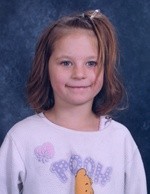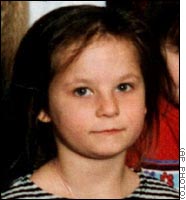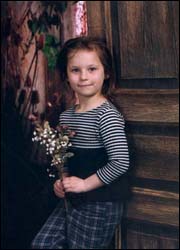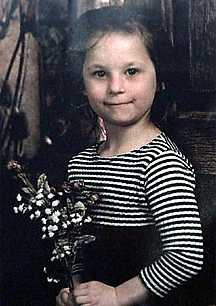Who killed Kayla Rolland? A six-year-old classmate did it. On Tuesday morning he went to the Theo J. Buell Elementary School carrying both a concealed Davis .32 semiautomatic handgun, advertised as "the original pocket pistol," and a knife. Another kid reported the knife to a teacher, and it was taken away. The boy held on to the gun. Shortly before 10 a.m., Chris Boaz, a seven-year-old, witnessed the following scene:
The children were changing classrooms, from a small reading group to a computer-training class. This is contrary to the police report that the crime occurred inside a classroom. The kids were on the first level heading to the second when the boy pulled out his pistol. Kayla was walking ahead of him, up the school stairs. He called out, "I don't like you." She had her back to him, then turned and asked, as a challenge, "So?" The boy, who had first pointed the gun at another classmate, swung around and fired a single bullet that entered Kayla's right arm and traveled through her vital organs. Boaz says he saw blood on both sides of Kayla's stomach. She grabbed her stomach, then her neck, gasping for air.
The shooter ran to the bathroom to hide and tossed the gun into the trash. Kayla was treated by paramedics at the school and was taken to Hurley Medical Center, where she was pronounced dead at 10:29 a.m.
Immediately after the shooting, the principal made an announcement over the public-address system ordering teachers to lock all classroom doors. The school was closed at 11 a.m., and police were called for crowd control when distraught parents rushed to pick up their children. The boy, who did not attempt to run away, was taken to the principal's office, where he was questioned, and later to a police station.
The boy's father Dedric Owens is in jail for violating parole after serving time for possession of cocaine "with intent to deliver." The boy and his eight-year-old brother had been living with their mother Tamarla until recently, when she was evicted. The two boys then moved into a crack house, where guns were traded for drugs, with their uncle and the 19-year-old man who left the murder weapon, evidently loaded, under some blankets. A search of the house produced a loaded pump-action shotgun and a rock of crack cocaine. The boy and his brother had been sharing a single sofa as a bed.
Outside the white clapboard house, dented hubcaps and other discarded auto parts lay strewn among candy wrappers, soda bottles and wires. Broken windows were covered with a blue tarp. A light so dim it might have been a continuation of the dark showed from inside. Of the boy, Genesee County Sheriff Robert Pickerell said, "He was basically living in hell."
Who killed Kayla Rolland? The hell in which the boy lived has to be partly responsible, because it helped produce a child full of rage and confusion. The boy was said to have played normal street games. He was also known to have started fights. Boaz said the boy once punched him because he wouldn't give him a pickle. He said the boy was made to stay after school nearly every day for saying "the F word," flipping people off, pinching and hitting. Some weeks before, he had stabbed a girl with a pencil. He had attacked Kayla before and, on the day prior to the killing, tried to kiss her and was rebuffed.
Early on the morning of the shooting, he and his brother got into a fight with Boaz's 10-year-old uncle. Boaz's uncle punched the boy, who said, according to Boaz's grandmother, "Do you want me to take my gap [sic] out and shoot you?" The boy's father once asked his son, "Why do you fight?" The boy replied, "I hate them."
With a record of behavior like this, one might ask why no one was paying more helpful attention to him. The teacher to whom the knife was reported did not take him to the principal's office, where he could have been searched. There is no sign that any social-service organization was watching, or even that one was in the vicinity. His parents were worse than useless to him. Tamarla, a drug addict, admitted that she exposed her children to marijuana regularly. Boaz's mother tried to comfort her son, who is growing increasingly agitated about the killing he saw and does not want to return to school. She explained that the boy who did the shooting "cried out for help, and nobody helped him."
Not family. Not school officials. Not any social-service agency. Not the police. The people who lived next door to the crack house reported conditions there many times, but the police did not respond. One neighbor said, "It took a killing to get these people out of here."
The last thing that the opponents of gun control wish to hear is that guns too are partly responsible for killing Kayla, but of course they are. In response to the child's death, President Clinton challenged Congress to break the logjam on gun legislation. Senator Orrin Hatch and Representative Henry Hyde, chairmen of the Senate and House Judiciary committees, which have failed since last summer to get through a compromise bill with modest strictures on the sale and possession of weapons and a requirement that guns be sold with trigger locks, agreed last week to meet with the President at the White House. On the Today show, Clinton said that while the bill has stalled, "every single day there are 13 children who die from guns."
Among the compromise bill's more contentious items are the regulation of gun shows and background checks for gun sales. Polls indicate that more people favor stronger gun control and that more are willing to make it a voting issue in the coming elections. But the atmosphere in the Republican Congress remains inhospitable to any effective bill.
A proposal to have background checks for a mere three business days barely passed the Senate last year after the killings at Columbine. The day after the President appeared on Today, a representative of the National Rifle Association repeated the equally true and irrelevant argument that what happened in Michigan was the fault of parents, not guns.
The boy did the shooting, but how responsible is he for the act? The law in most states contends that under the age of seven, a child cannot understand the consequences of a criminal act, and indeed, the police said the boy--in spite of his history of violent behavior--did not seem to comprehend the gravity of what he had done. The Genesee County prosecutor said the boy could not have formed criminal intent.
The legal matter here is easier to deal with than the question of his awareness of good and evil. The influences on the boy at home could have armed him with the urge for revenge. But how aware was he of a wrong act? And did he understand that death is irreversible? If he did, how can he be absolved of knowing the consequences?
Ron Avi Astor, of the School of Social Work and Education at the University of Michigan, says that "just because a child understands that a gun could cause serious harm and death doesn't mean that society needs to treat the six-year-old in the same way it would a 20-year-old. We understand that children are more vulnerable." He also notes that with more aggressive kids, provocation becomes paramount.
The boy who killed Kayla may have felt humiliated--by her, by everything--which became a justification for any act. Astor cautions, though, that culpability is just one piece of the problem. If we do not create a place and a structure for children as a whole, he says, "we'll see groups of children who should have been treated earlier committing horrible acts."
Whatever one concludes about responsibility, this incident will end as too many child killings have ended in recent years--with mournful speeches and eulogies and civic burial mounds made up of heart-shaped balloons, poems, and stuffed animals staring blankly into space. At least that is how it will end for Kayla.
For the boy, who can tell? The state will probably take custody of him, his brother and five-year-old sister. It is possible that an enlightened environment somewhere will produce a wholly different child, and just as possible that the wounds go too deep and that he will emerge into adulthood knowing perfectly the meaning and consequences of criminal acts as he blithely commits them.
Last week the nation went through the sort of moment that is growing too familiar not only in content but also in the emotions it engenders. On the same day, one could feel heartbroken and fearful that one's children were in danger in their schools, and yet, also, that this is the way life goes these days, and who, after all, can do anything about it? If that attitude of inevitability prevails, some would say it answers the question "Who killed Kayla Rolland?"
Five years after school shooting, Michigan community still in pain
By Dee-Ann Durbin - SignOnSanDiego.com
February 28, 2005
MOUNT MORRIS TOWNSHIP, Mich. – Buell Elementary School sits vacant, its windows dark, the schoolyard silent under a blanket of snow.
But in the air, there's a ghostly echo: The sound of the gunshot that killed 6-year-old Kayla Rolland five years ago. The shooting shocked the country because of Kayla's age and because police said her killer was her 6-year-old classmate.
Five years later, many things have changed in this Genesee County community of 24,000 that borders Flint. Buell closed its doors in 2002 because of declining enrollment and students were moved to another school in the district. Kayla's principal and superintendent have retired and her teacher moved elsewhere.
Former Genesee County Prosecutor Arthur Busch, who handled the case, said community members came together despite attempts by some groups to turn the shooting into a racial incident. Kayla was white and the shooter was black.
Someone donated new playground equipment to Buell and the township was showered with government grants for policing and gun control efforts in the years after Kayla's death, Busch said. Arrests for weapons violations rose 31 percent in the county the year after the shooting, Justice Department statistics show.
In his 2002 film "Bowling for Columbine," Flint native Michael Moore even tried to deliver a photo of Kayla to Charlton Heston, then the president of the National Rifle Association.
Yet, Busch said not enough has changed in the township, where parents face some of the state's highest unemployment rates and the majority of kids are eligible for free or reduced-price lunches.
Delinquency and neglect cases still strain the system, he said.
"The ingredients that created this scenario still exist: child poverty, drugs, all that misery that comes with poverty. It may even be worse," Busch said. "Many people here feel helpless to deal with it."
Kayla was shot once in the chest in front of her teacher and fellow students on Feb. 29, 2000. Police said the shooter, who has never been named or prosecuted because of his age, found the gun in the house where he was staying and simply wanted to scare Kayla.
"He didn't even really know what he had done," said Ira Rutherford, who was superintendent of the school district when Kayla was shot.
Since the shooter could not be prosecuted, officials took a hard look at the adults in his life. Jamelle James, who kept the .32-caliber semiautomatic pistol in a shoe box, spent 2½ years in prison after pleading no contest to involuntary manslaughter. He was discharged from probation on Feb. 18, according to court filings.
The other adults in the case also have been in and out of the courts in the last five years.
Kayla's mother, 35-year-old Veronica McQueen, lost custody of her two surviving children in 2003. A judge found she failed to protect her teenage daughter from being molested by her husband, Michael McQueen, who was sentenced to three years of probation in 2004.
Veronica McQueen filed for divorce in November and now sees her children regularly, her attorney said.
She also sued Beecher Community School District, claiming officials knew the boy was a threat and at least one teacher knew he brought a gun to school. A federal judge dismissed the lawsuit last year, saying the district and teachers weren't at fault. McQueen is appealing.
McQueen, who works at a dry cleaning business in the Flint area, declined to speak directly to The Associated Press. Her attorney said she will spend part of this week at the child's grave.
"She is enduring a natural mother's worst nightmare," her attorney, J. Dallas Winegarden, said. "She hopes something good has come out of this as far as school safety and gun safety are concerned."
Tamarla Owens, the mother of the shooter, also lost custody of her two sons. She gave up parental rights to the boy who shot Kayla and his older brother, but she has regained custody of their younger sister, Busch said.
Owens did not respond to a request for comment placed through her attorney, Mark Clement. Busch said the two boys have needed increasing amounts of supervision as they've grown older. The shooter will turn 12 this spring, while his brother will turn 14.
"It's been a very difficult road for those boys, and it's very sad to me that despite having the best efforts that could ever be given to anybody ... they just haven't been at the top of their class," Busch said.
The
victim





